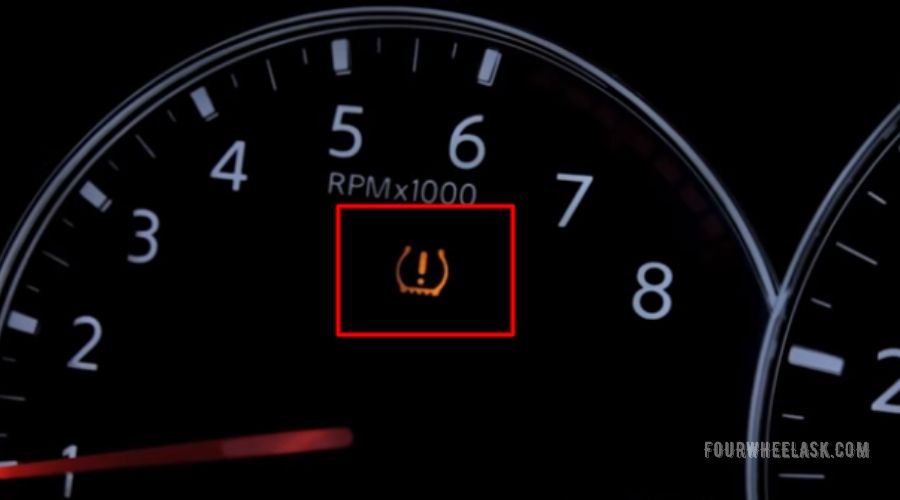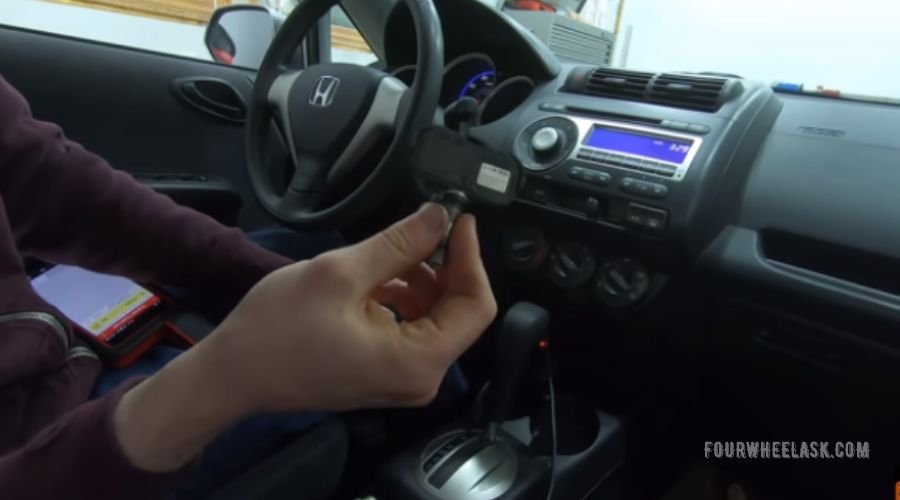Nissan Blinking Tire Pressure Light – 5 Reasons & Fix
Like most modern cars, Nissan’s tire pressure monitoring system (TPMS) helps drivers stay safe by warning them when their tires aren’t inflated properly. This system uses sensors on the wheels to measure tire pressure, and when the pressure is too low, the TPMS light glows up.
While low tire pressure is the most common cause of a blinking tire pressure light, several other reasons could be behind the issue. Here I list what I usually encounter:
- Low tire pressure
- Lost tire pressure sensor memory
- Faulty TPMS
- The TPMS requiring re-initialization
- Computer glitches
Over the years, I’ve had many stop by my garage complaining about their Nissan blinking tire pressure light. And in this article, I’ll show you how I’d go about fixing it.

what does Nissan Blinking Tire Pressure Light mean?
The tire pressure light on your Nissan is usually the yellow ‘exclamation point’ in an arched bracket symbol. This light is a warning indicating that one of your tires is 25% below the recommended pressure or that the sensors in the TPMS have an issue.
When the TPMS light starts blinking instead of remaining on, it means that there is a connectivity problem between the Monitor System and the Controller Area Network (CAN).
A blinking tire pressure light could also mean that the sensors in the wheel have failed or become disconnected.
I’ve also encountered a few cases where the TPMS light blinks dimly before staying on and remaining illuminated. This indicates a weak TPMS sensor battery.
Troubleshooting guide for Blinking Tire Pressure Light on Nissan
When a customer comes in with a blinking tire pressure light on their Nissan, I follow specific steps to determine its cause and resolve it accordingly. Here’s what I usually do:
#1. Fill-Up the Tires If the Pressure Is Low
The TPMS light is likely to stay on whenever there’s a drop in pressure in any of your tires. However, blinking signals can be rather sporadic and may be activated due to low tire pressure as well.
Various things can lead your Nissan tires to get low in pressure. The most apparent cause is underinflation, which can also result from leaks, punctures, wear-outs, or cold weather.
Therefore, the first check I perform is to use a pressure gauge to see if the tire pressures in all four tires are in a safe range.
It should be close to 30-35 psi, but I’d recommend looking up your car’s specific tire pressure requirement. If the inflations are lower than the recommended, I simply fill them to the appropriate levels to get the TPMS light to stop flashing.
#2. Reset Your Nissan’s Tire Pressure Light to Re-establish Communication
Sometimes the tire pressure light keeps blinking even after you’ve filled your tires. It can be due to a lost connection between the monitor system and the controller or a lost memory in the TPMS sensor. In such cases, resetting the TPMS light did the trick for me most of the time.
Also, resetting the TPMS sensors is necessary each time you rotate, swap, or replace your wheels. This ensures the sensors work correctly and send the correct tire pressure from the new wheel location.
The resetting process in Nissan vehicles differs between models. So, it’s best to refer to your car’s owner’s manual to precisely follow the instructions. But typically, it’s done using a TPMS reset button in most models, located either near the steering wheel or inside the driver’s door.
How to Reset the TPMS in Nissan?
Unfortunately, merely pushing it won’t do the trick for you, as I’ve seen from my experience. Here’s how to use the Nissan TPMS reset button correctly.
- Put the key in the “On” position without turning on the vehicle’s engine.
- Press the reset button and hold it in place. Only release it when the tire pressure light has flashed three times.
- Once you start the car, allow the sensor to refresh for at least 20 minutes.
However, if your car has no reset button, you can use the Nissan TPMS reset tool for a quick and permanent fix. Follow this video for detailed guidance.
Alternatively, you can speed your car up to 50 mph for ten minutes so it resets the TPMS the next time you start it.
I’ve also found that some Nissan models reset the TPMS when you overinflate your tires, then deflate and reinflation them to the recommended pressure.
#3. Replace and Relearn the Faulty TPMS Sensor

Due to their positioning inside the wheel, dirt and grime can accumulate on the tire pressure sensors, leading to deterioration. But don’t worry, replacing them is easy and only takes a few minutes with the right tools. You’ll also need to reprogram them, which, too, is a simple process.
To do it, you can use a Nissan TPMS relearn tool. It sends signals to the TPMS sensors from outside the wheel and attempts to repair the connection lost between the monitor and the wheel sensors. Here’s how I usually go about it:
- Remove the old TPMS sensors and replace them with new ones.
- Check the vehicle placard for the recommended tire pressure, and inflate all tires accordingly.
- Begin scanning each tire sensor with the scan tool in the specified sequence. Start with the LF tire, and move on to the RF, RR, and LR (and full-size spare if it has a sensor).
- Engage the ignition but keep the engine OFF. Be sure to avoid the ACC position.
- Transfer the sensor IDs by connecting the tool to the OBDII port.
- Now, switch off the ignition and scan each sensor again.
- Keep a constant eye on the low tire pressure monitor while driving the vehicle over 30mph for a minimum of 10 minutes to ensure it flashes no more.
#4. Reconnect or Replace Your Car’s Battery to Pass Computer Glitches
On multiple occasions, it has come to my attention that a Nissan blinking tire pressure light is typically due to a computer malfunction. In these cases, there’s no actual issue with the tires. And simply reconnecting the battery terminals did the fix for me.
To do it, switch off the car and remove the negative cable from its battery. Then, after a few minutes, reinstall and tightly secure both positive and negative terminals to the battery. And finally, start the car and check if the light has stopped glowing.
If, despite the efforts, the TPMS light continues, it could be due to a weak battery or damaged wiring. In such cases, a replacement is the only option.
conclusion
To recap, here are the 5 Reason Nissan Blinking Tire Pressure Light:
- Low tire pressure
- Lost tire pressure sensor memory
- Faulty TPMS
- The TPMS requiring re-initialization
- Computer glitches
If none works for you, I recommend taking the car to your nearest Nissan dealership. They’ll have the expertise and equipment that a regular mechanic might not have access to. Also, they’ll accurately identify what’s going wrong and find a solution tailored to your exact Nissan model.
And lastly, don’t forget to keep your tires regularly inspected and filled to the right pressure level. It’s the best and simplest habit you can cultivate to keep them in top shape and ensure safe driving.
Video References
Repair Geek
Willis Nissan
Related Articles:
- What Causes Prius Tire Pressure Light Blinking?
- What Does The Blinking Tire Pressure Light Subaru Mean?
- What Causes Toyota Tire Pressure Light Blinks Then Stay On?
Certification: BSc in Mechanical Engineering
Education: Mechanical engineer
Lives In: 539 W Commerce St, Dallas, TX 75208, USA
Rasel is an auto mechanic student and writer with over half a decade of experience in the automotive field. He has worked with top automotive brands such as Lexus, Quantum, and also owns two automotive blogs autocarneed.com and taxiwiz.com.